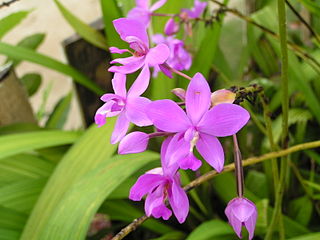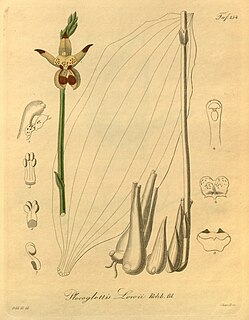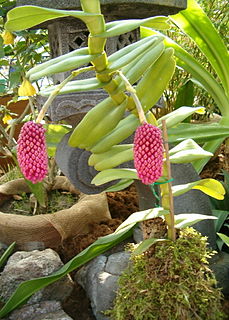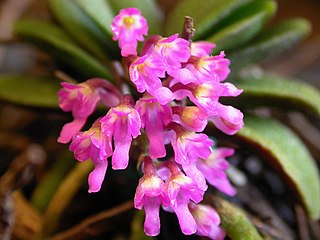
Spathoglottis, commonly known as purple orchids or 苞舌兰属 is a genus of about fifty species of orchids in the family Orchidaceae. They are evergreen terrestrial herbs with crowded pseudobulbs, a small number of leaves and medium-sized resupinate flowers on an upright flowering stem. The sepals and petals are all similar to each other and are white, yellow, pink or purple. Species of Spathoglottis are found from eastern and south-eastern Asia to Australia and some Pacific Islands.

Calanthe, commonly known as Christmas orchids, is a genus of about 220 species of orchids in the family Orchidaceae. They are evergreen or deciduous terrestrial plants with thick roots, small oval pseudobulbs, large corrugated leaves and upright, sometimes arching flowering stems. The sepals and petals are narrow and a similar size to each other and the labellum usually has spreading lobes.

Plocoglottis is a genus of orchids, native to Southeast Asia and to various islands from the Andaman Islands to the Solomons.

Tainia, commonly known as ribbon orchids or 带唇兰属 is a genus of about thirty species of evergreen, terrestrial orchids in the distributed from India, China, Japan, Southeast Asia to New Guinea, the Solomon Islands and Queensland.

Zeuxine, commonly known as verdant jewel orchids, is a genus of about eighty species of orchids in the tribe Cranichideae. They are native to parts of tropical Africa, Asia, Southeast Asia, New Guinea, Australia and some Pacific Islands. They have relatively narrow, dark green leaves and small, dull-coloured resupinate flowers with the dorsal sepal and petals overlapping to form a hood over the column. The labellum has a pouched base and its tip has two lobes.

Corybas, commonly known as helmet orchids, is a genus of about 120 species of plants in the orchid family, Orchidaceae. Helmet orchids are small, perennial, deciduous herbs and are nearly always terrestrial. They have a single leaf at their base and a single flower on a short stalk, the flower dominated by its large dorsal sepal and labellum. Species of Corybas are found in Australia, New Zealand, New Guinea, Southeast Asia, the Himalayas, southern China, many Pacific islands and a few sub-Antarctic islands.

Phreatia, commonly known as lace orchids, is a genus of flowering plants from the orchid family, Orchidaceae, native to regions bordering the Pacific and Indian Oceans. Plants in this genus are epiphytes, sometimes with pseudobulbs, in which case there are usually one or two leaves. Others lack pseudobulbs but have up to twelve leaves. A large number of small white or greenish flowers are borne on a flowering stem emerging from a leaf axil or from the base of the pseudobulb when present but the flowers do not open widely. There are about 220 species, distributed from tropical and subtropical Asia to the Pacific.

Tropidia, commonly known as crown orchids, is a genus of about thirty species of evergreen terrestrial orchids in the family Orchidaceae. They have thin, wiry stems with two or more tough, pleated leaves with a flowering spike at the top of the stem, bearing crowded flowers. Species in this genus are distributed across the warmer parts of both the Eastern and Western Hemispheres.

Robiquetia, commonly known as pouched orchids, or 寄树兰属 , is a genus of flowering plants from the orchid family, Orchidaceae. Plants in this genus are epiphytes with long, sometimes branched, fibrous stems, leathery leaves in two ranks and large numbers of small, densely crowded flowers on a pendulous flowering stem. There are about eighty species found from tropical and subtropical Asia to the Western Pacific.

Trichoglottis, commonly known as cherub orchids or 毛舌兰属 , is a genus of flowering plants in the family Orchidaceae. Orchids in this genus are epiphytic plants with thick roots, relatively thick, fibrous stems and many large, thick, leathery leaves arranged in two ranks. The flowers are usually small and yellowish with light brown or purple markings. The flowers have broad sepals, narrower petals and a labellum which has three lobes and is often hairy. There are about 85 species distributed from tropical and subtropical Asia to the north-western Pacific. Most species grow in rainforest.

Pholidota, commonly known as rattlesnake orchids, is a genus of flowering plants from the orchid family, Orchidaceae. Plants in this genus are clump-forming epiphytes or lithophytes with pseudobulbs, each with a single large leaf and a large number of small, whitish flowers arranged in two ranks along a thin, wiry flowering stem that emerges from the top of the pseudobulb. There are about thirty five species native to areas from tropical and subtropical Asia to the southwestern Pacific.

Cryptostylis, commonly known as tongue orchids, is a genus of flowering plants from the orchid family. Tongue orchids are terrestrial herbs with one to a few stalked leaves at the base of the flowering stem, or leafless. One to a few dull coloured flowers are borne on an erect flowering stem. The most conspicuous part of the flower is the labellum, compared to the much reduced sepals and petals. At least some species are pollinated by wasps when they attempt to mate with the flower. There are about twenty five species found in South Asia, Southeast Asia and the South Pacific.
Erythrodes is a genus of flowering plants from the orchid family, Orchidaceae. It contains 26 currently recognised species, native to Southeast Asia, China, the Indian Subcontinent, New Guinea, and some islands of the Pacific.
- Erythrodes amboinensis(J.J.Sm.) J.J.Sm. - Ambon
- Erythrodes bicalcarata(R.S.Rogers & C.T.White) W.Kittr. - New Guinea
- Erythrodes bicarinataSchltr. - New Guinea, Vanuatu
- Erythrodes blumei(Lindl.) Schltr. in K.M.Schumann & C.A.G.Lauterbach - from Assam east to Taiwan, south to Java
- Erythrodes boettcheriAmes - Luzon
- Erythrodes celebensisP.O'Byrne - Sulawesi
- Erythrodes forcipataSchltr. - New Guinea
- Erythrodes glandulosa(Lindl.) Ames - Borneo
- Erythrodes glaucescensSchltr. - New Guinea
- Erythrodes hirsuta(Griff.) Ormerod in G.Seidenfaden - Hainan, Assam, Bhutan, Myanmar, Thailand, Vietnam
- Erythrodes humilis(Blume) J.J.Sm. - Java, Sumatra, peninsular Malaysia
- Erythrodes johorensis(P.O'Byrne) Ormerod - peninsular Malaysia
- Erythrodes latifoliaBlume - Java, Sumatra, peninsular Malaysia
- Erythrodes latilobaOrmerod - Sri Lanka
- Erythrodes oxyglossaSchltr. - Fiji, New Caledonia, Samoa, Tonga, Vanuatu, Wallis & Futuna
- Erythrodes papuanaSchltr. in K.M.Schumann & C.A.G.Lauterbach - New Guinea
- Erythrodes parvulaKores - Fiji, Tonga
- Erythrodes praemorsaSchltr. - New Guinea
- Erythrodes purpurascensSchltr. in K.M.Schumann & C.A.G.Lauterbach - New Guinea, Fiji, Tonga, Samoa
- Erythrodes sepikanaSchltr. - New Guinea
- Erythrodes sutricalcarL.O.Williams - New Guinea
- Erythrodes tetrodontaOrmerod - New Guinea
- Erythrodes torricellensisSchltr. - New Guinea
- Erythrodes trilobaCarr - Sabah
- Erythrodes weberiAmes - Philippines
- Erythrodes wenzeliiAmes - Philippines

Thelasis, commonly known as fly orchids, is a genus of flowering plants from the orchid family, Orchidaceae. Plants in this genus are usually epiphytes, sometimes lithophytes or rarely terrestrials. Some species have pseudobulbs with up to three leaves, whilst others have several leaves in two ranks. A large number of small, white or greenish yellow flowers are borne on a thin, arching flowering stem. There are about thirty species, distributed from tropical and subtropical Asia to the southwest Pacific.

Hetaeria, commonly known as hairy jewel orchids, is a genus of about thirty species of flowering plants in the orchid family Orchidaceae. Plants in this genus are terrestrial herbs with a succulent rhizome and a loose rosette of leaves. Small, pale, hairy non-resupinate flowers are borne on a thin, hairy flowering stem. They are found in tropical Africa and Asia to New Guinea, Australia and some Pacific Islands.
Hippeophyllum is a genus of flowering plants from the orchid family, Orchidaceae. It is native to New Guinea, insular Southeast Asia, and the Solomon Islands.
- Hippeophyllum albovirideJ.J.Sm. - New Guinea
- Hippeophyllum biakenaeJ.J.Sm. - New Guinea
- Hippeophyllum celebicumSchltr. - Sulawesi
- Hippeophyllum halmaherenseJ.J.Sm. - Halmahera
- Hippeophyllum hamadryas(Ridl.) Schltr. in K.M.Schumann & C.A.G.Lauterbach - New Guinea
- Hippeophyllum micranthumSchltr. in K.M.Schumann & C.A.G.Lauterbach - New Guinea, Solomon Islands
- Hippeophyllum papillosumSchltr. - New Guinea
- Hippeophyllum scortechinii(Hook.f.) Schltr. - Borneo, Java, Malaysia, Sulawesi, Sumatra
- Hippeophyllum sulenseJ.J.Sm. - Sula Islands in Maluku
- Hippeophyllum wenzeliiAmes - Leyte

Micropera, commonly known as dismal orchids or 小囊兰属 is a genus of about twenty species of flowering plants from the orchid family, Orchidaceae. Plants in this genus are large epiphytes with thick roots, long, fibrous stems, linear leaves and whitish or yellow, non-resupinate flowers. The sepals and petals are similar to each other and the labellum is shoe-shaped or sac-like and has three lobes. It is found from Tibet to tropical Asia and the western Pacific Ocean.

Peristylus, sometimes commonly known as ogre orchids or bog orchids is a genus of flowering plants from the orchid family, Orchidaceae. It consists of over 100 known species found across much of eastern and southern Asia as well as in Australia and on many islands of the Indian and Pacific Oceans.

Schoenorchis, commonly known as flea orchids, or 匙唇兰属 , is a genus of flowering plants from the orchid family, Orchidaceae. Plants in this genus are small epiphytes with thin roots, thin leafy stems with leaves in two ranks and tiny fragrant, almost tube-shaped flowers with a prominently spurred labellum. There are about twenty five species found from tropical and subtropical Asia to the Western Pacific.

Rhomboda, commonly known as velvet jewel orchids, is a genus of about twenty species of flowering plants in the orchid family Orchidaceae. Plants in this genus are mostly terrestrial herbs with a fleshy, creeping rhizome and a loose rosette of green to maroon coloured leaves. Small resupinate or partly resupinate, dull coloured flowers are borne on a hairy flowering stem. The dorsal sepal and petals overlap and form a hood over the column and there is a deep pouch at the base of the labellum. They are found in tropical regions from northern India through Southeast Asia, China, Japan to Australia and some Pacific Islands.


















